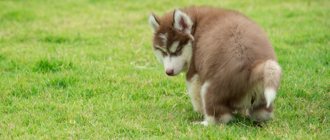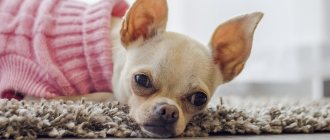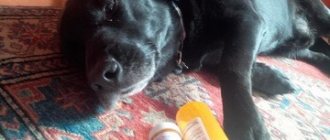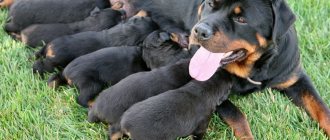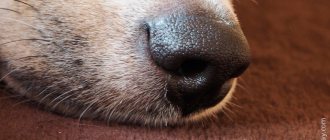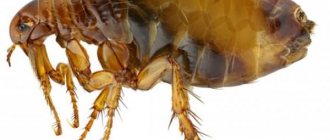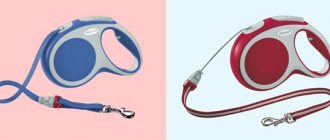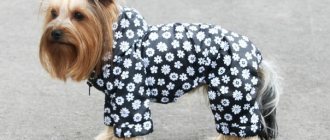Seborrheic dermatitis in dogs is a genetic pathology and is predominantly inherited. Most often it occurs in dogs and horses, and much less often in sheep, as well as in cattle. Externally, the disease manifests itself in an increase in the intensity of the action of the sebaceous glands and in changes in the composition of the skin, which is accompanied by a noticeable inhibition of the processes of regeneration of the horny substance (keratinization). From this article you will learn about the forms of the disease, characteristic symptoms and diagnostic methods, as well as the features of the treatment of seborrhea and the use of special means.
Features of the pathology
Seborrhea is a fairly common pathology that manifests itself in dogs in two forms.
One of them is called primary and belongs to the category of genetic (that is, inherited). The following fairly common dog breeds are most often affected by this form:
- cocker spaniels (in particular American ones);
- bulldogs of the so-called “English” color;
- basset hounds;
- German Shepherds, Dachshunds and other breeds.
This type of disease is usually explained by an excess of epidermis in the outer skin, which is often accompanied by the release of a large amount of fatty components.
In a healthy body, metabolic processes are regular; At the same time, dead skin particles fall off, and new ones form in their place.
Seborrhea in dogs is caused by an imbalance between two differently directed processes: the death and formation of skin scales during metabolism in the epidermis (in the outer layer of the skin).
Another type of this pathology is called secondary and develops after suffering or against the background of so-called “internal” skin lesions, namely:
- for diseases from the group of allergic and sometimes endocrine pathologies (diabetes mellitus or hyperadrenocorticism);
- if there is a lack of special vitamins and minerals in the animal’s diet, as well as due to metabolic disorders in the body (dermatitis, dermatosis, as well as nutritional imbalance);
- with the manifestation of typical immune diseases such as lupus erythematosus, sebaceous adenitis or erythematous pemphigus;
- after being affected by skin parasites or suffering from diseases such as pediculosis, scabies, demodicosis or otodecosis.
In addition, secondary pathology can be detected after various types of infectious diseases (dermatitis, pyoderma, and leishmaniasis).
Clinical picture
In dogs, seborrhea usually affects areas of the skin that are particularly rich in sebaceous glands. Thus, in almost all cases the skin along the vertebral ridge is affected . In these cases, you can see not only greasy skin and fur, but also dandruff, which appears in the form of large flakes.
The dog's spine looks as if it has been caught in heavy snow. The skin may become noticeably red. Contrary to popular belief, with seborrhea, the epithelial layer does not always become greasy - sometimes it dries out noticeably, causing the skin of dogs with seborrhea to become scaly.
Seborrheic dermatitis is most severe in cases where areas with folds of the skin are affected, that is, legs, neck, armpits, and inner thighs. In addition, the symptoms of seborrhea often involve the appearance of a heavy, unpleasant odor from the animal. As the disease worsens, when seborrhea is accompanied by bacterial and fungal infections, the “aroma” can become completely unbearable.
Symptoms of the disease
At the initial stage, seborrhea in dogs is clearly manifested in a change in coat color (fading) and the appearance of slight skin peeling. These minor deviations from the norm are not taken seriously by the owner at first, but as they develop they turn into a problem for him that requires immediate action.
In the case of the primary form, the characteristic signs of the disease are as follows:
- change in fur shade (fading);
- the appearance of small scales on the skin (in common parlance - dandruff);
- inflammation with simultaneous redness of its individual areas;
- increased unpleasant odors characteristic of the dog;
- the appearance of characteristic “plaques” on the affected areas, a “greasy” shade of fur, itching, as well as brittleness of the claws and the formation of noticeable thickenings on the paw pads.
These symptoms of the primary disease can be found on almost any part of the dog’s skin, but in the vast majority of cases they affect the ears, head, groin, as well as the interdigital areas of the skin and its folds.
First of all, clearly visible traces of this lesion appear on the ears of your pet. Therefore, it is this part of the dog’s body that a caring owner should pay attention to first.
Treatment of dandruff in dogs
Accurate diagnosis of the cause of the disease takes a lot of time, so start treatment immediately, change housing and feeding conditions, and use symptomatic remedies.
If dandruff appears during the heating season, purchase an air humidifier, remove decorative plants from the apartment, limit the use of perfumes, and do not smoke in the presence of your pet. In summer, protect your dog from the heat by using a cooling blanket or scarf.
For any reason for dandruff, organize your diet. I recommend using ready-made medicated food for dogs with skin diseases - Eukanuba Dermatosis or Hill's. For older pets with kidney failure, Royal Canin Anallergenic is suitable.
If you use natural nutrition, enrich your diet with vitamin supplements, after consulting with specialists. Stop treating your dog with delicacies - chocolate, candies, sausage, smoked meats, fried, fatty, salty foods.
Replace skin care products, use professional shampoos, we will discuss them in more detail below. If dandruff appears as a result of stress, use sedatives. I recommend Stop-stress, Fitex or Kot Bayun. Check out our review of dog sedatives.
To combat fleas, lice, and skin mites, use insectoacaricidal aerosols. I recommend Bolfo or Frontline. Popular drops that are applied to the skin along the spine are Advantix or Stronghold. Check out reviews of flea and tick drops and ear mite treatments.
Hormonal imbalances are treated conservatively and surgically. Since a dog with endocrine pathologies loses its breeding value, I recommend a radical method of treatment - castration.
Brush loose hair frequently during shedding. This applies primarily to long-haired pets. Use anti-tangle shampoos, use tangle cutters. Watch the video:
In most cases, dandruff appears as a symptom of an underlying disease. Seborrhea disappears after recovery as a result of treatment or rehabilitation. Therefore, veterinary care cannot be avoided in such situations. Follow the instructions of the specialist treating the underlying condition.
Review of anti-dandruff shampoos
The main method of treating seborrhea is the use of skin care products that have the following properties:
- antiseptic;
- insectoacaricidal;
- antipruritic;
- antimycotic;
- nourishing the skin.
The therapeutic effect is achieved when the cause of seborrhea is eliminated. Use the remedy prescribed by your veterinary dermatologist. I have prepared a review of popular anti-dandruff shampoos that are positively rated by experts and consumers:
- Doctor;
- 8in1 Shampoo Medicated;
- Veterinary Formula;
- Beaphar Anti-Dandruff Shampoo;
- Cytoderm;
- Globalvet.
To eliminate dandruff, use Doctor shampoo with tar, climbazole or chlorhexidine. The product is suitable for all pets, regardless of hair length. The dog is washed for 3 days in a row or according to the schedule recommended by the veterinarian.
Pre-wet your dog. Rub the shampoo in until the entire pet is covered in foam. Leave for 6-8 minutes and rinse off. Dry the dog with a towel, lay it on the rookery, and let it dry. Do not use a hairdryer, close the windows and doors to prevent drafts. Do not bathe your dog more often than your veterinarian recommends, otherwise the skin will begin to peel. There are positive and negative reviews for the drug.
The cost of a 200 ml bottle is 280 rubles.
Watch the video on how to wash small dogs:
8in1 Medicated tar shampoo with the scent of pine needles eliminates itching, moisturizes the skin, and has an antiseptic and wound-healing effect. The detergent is used in the same order as Doctor shampoo. A 473 ml bottle costs 474 rubles.
Watch a video on how to wash large dogs:
Veterinary Formula Antiseborrheic Shampoo is prescribed to dogs over 12 weeks of age. It has antiseptic and anti-inflammatory properties. Removes excess fat, eliminates itching, promotes wound healing, exfoliates scabs, normalizes the secretion of the sebaceous glands. Does not stop the action of previously applied insectoacaricides. The shampoo is pre-mixed with water in a ratio of 1 to 2-3.
The cost of a 453 ml bottle is 773 rubles.
Beaphar Anti-Dandruff Shampoo cleanses the skin and coat without disturbing their protective layer. The recipe contains salicylic acid and natural oils - calendula, bergamot and lavender. The components of the shampoo have an antihistamine effect and strengthen the hair roots. The reaction of the environment is neutral, the cosmetic product smells like pine. Rub the shampoo in until a rich foam forms, leave for 3 minutes, rinse and dry with a towel. The cost of a 200 ml bottle is 900 rubles.
Cytoderm gets rid of dandruff and prevents its reappearance. Climbazole destroys pathogenic micromycetes. Zinc pyrithione restores the protective barrier of the skin, stops inflammation, and normalizes the functioning of the sebaceous glands. Aloe Vera moisturizes the skin and stops itching. Under the influence of malic acid, the exfoliation of keratinized scales and the renewal of the epidermis are accelerated.
Price - 400 rub.
Anti-dandruff shampoo GlobalVet improves the functioning of the sebaceous glands, normalizes the microflora of the skin, and destroys pathogenic micromycetes. Contains olive oil, pyrithione zinc, salicylic acid. The pet is bathed daily until complete recovery. The cost of a 150 ml bottle is 370 rubles.
Vitamins
There are no special vitamin preparations available for the treatment of dandruff in dogs. However, dietary supplements designed to improve skin health and coat beauty can be of undoubted benefit. The components of dietary supplements have a positive effect on the secretion of the sebaceous glands, therefore they are effective in eliminating dandruff.
If your dog consumes ready-made food of premium class or higher, it does not need additional vitamins. They are included in granules or canned food.
But when dandruff appears with a balanced diet, there may be a need for additional vitamins. Don't take risks, consult your veterinarian. It's not just a matter of overdose. There is a danger of drug interaction between dietary supplement components and finished feed.
If you feed your dog factory-made economy-class food or natural food, feel free to buy dietary supplements from leading manufacturers from a trusted seller. The basic diet is poor in vitamins. If you follow the instructions for using vitamin supplements, an overdose, as well as unwanted drug interactions, will not occur.
Most dietary supplements contain the following components:
- B vitamins. Manufacturers of liquid dietary supplements use synthetic vitamin preparations. Dry vitamin supplements use a natural concentrate of biological catalysts - brewer's yeast. The walls of micromycetes consist of mannanoligosaccharides with prebiotic activity. This is another argument in favor of brewer's yeast.
- A complex of antioxidants from ascorbic acid, histidine, vitamin E. Not present in all dietary supplements.
- Amino acids are essential for wound healing and hair growth.
- Microelements - zinc, which ensures healthy skin, copper, which is necessary for ensuring pigmentation of the coat. Not present in all dietary supplements.
- Essential Omega 3; 6 unsaturated acids. They certainly have a positive effect on the beauty of the coat and the health of the skin. However, the acid content of a natural or economy diet is unknown, and an imbalance can be harmful.
- L-carnitine. Accelerates energy metabolism. Therefore, skin healing and coat renewal occurs faster. Not present in all supplements.
The characteristics of popular dietary supplements are given in the table:
| Indicators | Name of dietary supplement | ||||
| Polidex Super Vul Plus | Biotin Forte | Beaphar Laveta Super Vitamins | Anivital CaniDerm | Beaphar Vitamin B Complex | |
| Form | Pills | Tab. | Solution | Tab. | Rast. |
| Number of tablets or ml | 150 | 100 | 50 | 60 | 50 |
| Dosage | 1 tablet/5 kg weight | <5 kg – 0.5; 5-10 - 1; 10-20 - 1.5; >20 - 2 tables. in a day. Course – 6 weeks. | <2.5 kg - 5; 2.5-5 - 7; 5-10 - 11; 10-30 —22; >30 – 44 drops per day | 3 tablets/20 kg weight. Min. course - 4 weeks | <10 kg - 0.5; 10-20 - 1; >20 – 2 tsp. in a day |
| Price, rub. | 489 | 1040 | 547 | 1795 | 370 |
| Components | |||||
| Brewer's yeast | + | ||||
| Antioxidants | + | + | + | ||
| Amino acids | + | + | + | ||
| Microelements | + | + | |||
| Synthetic vitamins | + | + | + | + | + |
| L - carnitine | + | ||||
Folk remedies
External treatment of dogs against dandruff with folk remedies is a thing of the past. Shampoo manufacturers took into account the experience of dog breeders and prepared professional medicinal detergents based on it. But, non-traditional feed additives can be used as dietary supplements. It is known that brewer's yeast is a good source of B vitamins. Micromycetes multiply quickly and, for this purpose, accumulate large amounts of vitamins inside the cells. Manufacturers of dietary supplements took this quality into account.
In the 90s, we used feed yeast to improve the beauty of the coat and the health of the skin. They, like beer ones, contain high concentrations of vitamins. Yeast was sold in craft bags of 20-25 kg. We packaged it in 100 g quantities and developed instructions. The products were in demand among dog breeders in Moscow, Rostov-on-Don, Novorossiysk, Voronezh and other Russian cities. In 2021, the price of yeast was 45 rubles/kg, which is tens of times cheaper than factory-made vitamin supplements.
We have developed, tested on dogs and patented a product for the prevention and treatment of coat diseases of carnivorous animals, consisting of feed yeast, copper sulfate, tricalcium phosphate and methionine.
Diagnostic procedure
In order to correctly diagnose the onset of the disease and identify its symptoms, you should invite a veterinarian who has everything necessary to conduct clinical trials. In the course of his work, the invited specialist must take a number of steps to exclude signs of the primary disease (as a result of which it is often possible to diagnose seborrhea).
For this purpose, a purely visual examination is first carried out, during which the pet’s skin is examined for the presence of fungus, parasites or so-called “bacterial” infection. And only after that, blood, feces and urine tests are taken from him, as a result of which it will be possible to determine the presence of any internal problems that require treatment.
Sometimes, to obtain a complete picture of the symptoms, a biopsy of individual areas of the skin is performed.
If, after the examination and processing of the obtained tests, some kind of internal deviation is detected, the doctor, based on this, prescribes the appropriate method of treatment. If no concomitant diseases were identified during the diagnostic process, then the veterinarian makes a diagnosis of its primary form and gives recommendations on how treatment should be organized.
Features of the treatment process
According to most experts, diseases such as “primary seborrhea” are classified as incurable, so reasonable therapy can only be aimed at alleviating the dog’s current condition. At home, first of all, it is recommended to cut the dog short, which will ensure better penetration of the caring compounds into the skin affected by the disease.
Since this disease cannot be completely cured, try to make every effort to alleviate its course.
Before starting to treat the affected areas, the dog should be washed thoroughly. In this case, any traces of dirt on the wool are washed off with regular shampoo, and only after that it is allowed to use special products belonging to the category of cosmetics.
Recommended drugs for use
Shampoos
If seborrheic dermatitis is detected in dogs, antiseborrheic liquid shampoo (Tropicline) can be used. This drug is applied in small portions to areas of the skin damaged by the disease, after which it should be left for 10-15 minutes. The use of this cosmetic product helps the small scaly formations fall off due to their softening.
Upon completion of the skin treatment procedure, the remnants and traces of shampoo are thoroughly washed off with warm water. And after the skin has completely dried, the remaining scales are completely removed.
Of the known examples of antiseborrheic cosmetics, special attention should be paid to such affordable shampoos as Tropicline (USA) or domestic preparations such as Doctor (Russia), used when detecting “oily” seborrhea.
To alleviate your pet’s condition, such well-known cosmetics as “Globalvet” (Denmark), “Elite” (Russia), as well as shampoos called “Medicinal” or “Agrovetzaschita” are well suited. Their use is prescribed for those pets who have so-called “dry” seborrhea.
After using these types of shampoos, it is necessary to treat the skin with moisturizing conditioners containing natural oils or lanolin.
Special ointments and antibiotics
The category of special ointments recommended for use after removal of scaly formations includes:
- a special composition called “Zodak”, which alleviates the condition of the animal (relieves skin itching);
- Diprosalik cream, which helps relieve severe redness and gradually heal wounds from scratching;
- ointment composition “Cortisone”, recommended for use in diagnosing “oily” seborrhea and improving the functioning of the corresponding glands.
In the case of using an integrated approach to the treatment of seborrhea in a dog, the use of antimicrobial and special antifungal medications (for example, ketoconazole or ceftriaxone) is allowed.
These antibiotics help destroy microbial formations that spread due to infection in the affected skin areas. Along with these tablets, the doctor should prescribe drugs that ensure the safety of the intestinal microflora.
One should not lose sight of such an important procedure as fortification of the body, supported by the use of “A” preparations or vitamins containing zinc.
The procedure for using all of these products (their optimal dosage, in particular) is established in accordance with the current condition of the animal’s skin. The disease can be effectively treated only if the use of all drugs is strictly monitored by a specialist.
Moreover, any overdose of the medications prescribed for treatment can lead to a deterioration in the condition of your pet’s skin.
Treatment Basics
In each specific case, the veterinarian decides whether the treatment will be local or aimed at the entire body. Primary seborrhea is the most difficult to treat, since its manifestation is determined at the genetic level. In this case, it is completely impossible to defeat the disease, so only the symptoms are eliminated, driving the pathology into a long stage of latent course.
To prevent long hair from interfering with applying the medicine to the skin, it is recommended to cut the dog's hair during treatment. Before treatment with local preparations, the animal is washed and dried.
Treatment often uses a standard set of proven remedies.
Shampoos
A sick dog is washed only with special shampoos, for example, Tropicline. It is applied to damaged areas of the skin and left for 10-15 minutes to absorb the active substance. The product softens crusts and helps remove small scales. Thorough rinsing with water allows you to renew the skin where seborrhea is localized.
Specifics of caring for a pet
Everyday care of an animal with signs of primary seborrhea involves organizing its proper nutrition. The daily nutritional diet of a sick dog should contain natural supplements and vitamins that stimulate the metabolic processes occurring in the skin.
A pet with seborrhea must be prescribed a special diet, which must be followed for the rest of its life. It is advisable to agree on the diet with a veterinarian, who will help you adjust it taking into account the tests obtained. Since any deviation from the diet agreed upon with a specialist can lead to an exacerbation of the disease, its violation must be excluded.
In conclusion, we note once again that the so-called “genetic” or primary seborrhea is considered a practically incurable disease. As a result, the dog owner can only partially alleviate the condition of his pet and prevent the formation of infections of secondary origin. With timely and well-organized care, your pet will remain in excellent health and will not show any signs of concern from the problem.
Important Notes
Unfortunately, seborrhea today is increasingly complicated by the development of Staphylococcus aureus, which is extremely resistant to almost all the drugs described above. Because of this, it is strongly recommended that before prescribing antibiotics, culture is carried out on a nutrient medium, since otherwise you can feed your pet with strong antibiotics for a month, which will have no effect.
In case of seborrhea, complicated by the development of pathogenic and conditionally pathogenic fungi and yeast on the skin, the animal must be regularly bathed using special shampoos containing ketoconazole or fluconazole. In addition to destroying fungi, such products relieve itching and remove a layer of excess sebum from the skin, which helps eliminate seborrhea directly within three to four weeks. You just need to remember that such shampoos should not be used for more than a month (and they are used no more than twice a week), since in this case the normal microflora of the skin is catastrophically disrupted, as a result of which it will take a very long time for the animal to recover from seborrhea.
And further. Since treating seborrhea, complicated by the development of pathogenic microflora, often takes a very long time, the animal will constantly receive a wide variety of antibiotics during this period. And this has a very bad effect on the state of the gastrointestinal tract. Dogs already have a very weak intestinal microflora, but antibiotics kill it completely. What can be concluded? It's simple - after a long course of treatment for seborrhea using antimicrobial drugs, it is necessary (without fail) to feed your pet with probiotics . This will avoid many problems in the future.

